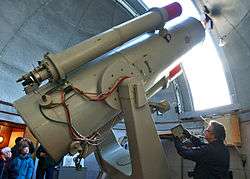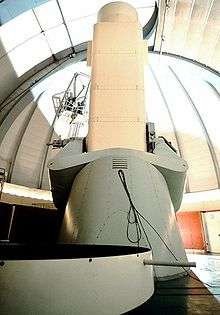Schmidt camera
.svg.png)

A Schmidt camera, also referred to as the Schmidt telescope, is a catadioptric astrophotographic telescope designed to provide wide fields of view with limited aberrations. The design was invented by Bernhard Schmidt in 1930.
Some notable examples are the Samuel Oschin telescope (formerly Palomar Schmidt), the UK Schmidt Telescope and the ESO Schmidt; these provided the major source of all-sky photographic imaging from 1950 until 2000, when electronic detectors took over. A recent example is the Kepler spacecraft exoplanet finder.
Other related designs are the Wright Camera and Lurie–Houghton telescope.
Invention and design
The Schmidt camera was invented by German-Estonian optician Bernhard Schmidt in 1930.[1] Its optical components are an easy-to-make spherical primary mirror, and an aspherical correcting lens, known as a Schmidt corrector plate, located at the center of curvature of the primary mirror. The film or other detector is placed inside the camera, at the prime focus. The design is noted for allowing very fast focal ratios, while controlling coma and astigmatism.[2]
Schmidt cameras have very strongly curved focal planes, thus requiring that the film, plate, or other detector be correspondingly curved. In some cases the detector is made curved; in others flat media is mechanically conformed to the shape of the focal plane through the use of retaining clips or bolts, or by the application of a vacuum. A field flattener, in its simplest form a planoconvex lens in front of the film plate or detector, is sometimes used. Since the corrector plate is at the center of curvature of the primary mirror in this design the tube length can be very long for a wide-field telescope.[3] There are also the drawbacks of having the obstruction of the film holder or detector mounted at the focus half way up the tube assembly, a small amount of light is blocked and there is a loss in contrast in the image due to diffraction effects of the obstruction and its support structure.[4]
Applications

Because of its wide field of view, the Schmidt camera is typically used as a survey instrument, for research programs in which a large amount of sky must be covered. These include astronomical surveys, comet and asteroid searches, and nova patrols.
In addition, Schmidt cameras and derivative designs are frequently used for tracking artificial earth satellites.
Ground based
The first relatively large Schmidt telescopes were built at Hamburg Observatory and Palomar Observatory shortly before the Second World War. Between 1945 and 1980, about 8 more large (1 meter or larger) Schmidt telescopes were built around the world.[5]
One particularly famous and productive Schmidt camera is the Oschin Schmidt Telescope at Palomar Observatory, completed in 1948. This instrument was used in the National Geographic Society - Palomar Observatory Sky Survey (POSS, 1958), the POSS-II survey, the Palomar-Leiden (asteroid) Surveys, and other projects.
The European Southern Observatory with a 1-meter Schmidt telescope at La Silla and the UK Science Research Council with a 1.2 meter Schmidt telescope at Siding Springs Observatory engaged in a collaborative sky survey to complement the first Palomar Sky Survey, but focusing on the southern hemisphere. The technical improvements developed during this survey encouraged the development of the Second Palomar Observatory Sky Survey (POSS II).[6]
The telescope used in the Lowell Observatory Near-Earth-Object Search (LONEOS) is also a Schmidt camera. The Schmidt telescope of the Karl Schwarzschild Observatory is the largest Schmidt camera of the world.
Space based
A Schmidt telescope was at the heart of the Hipparcos satellite from the European Space Agency (1989–1993). This was used in the Hipparcos Survey which mapped the distances of more than a million stars with unprecedented accuracy - this included 99% of all stars up to magnitude 11. The spherical mirror used in this telescope was extremely accurate; if scaled up to the size of the Atlantic Ocean, bumps on its surface would be about 10 cm high.[7]
The Kepler photometer, mounted on the Kepler probe, and orbiting since March 2009, is the largest Schmidt camera launched into space.
Other applications
Starting in the early 1970s, Celestron marketed an 8-inch Schmidt Camera. The camera was focused in the factory and was made of materials with low expansion coefficients so it would never need to be focused in the field. Early models required the photographer to cut and develop individual frames of 35 mm film as the film holder could only hold one frame of film. About 300 Celestron Schmidt Cameras were produced.
The Schmidt system was popular, used in reverse, for television projection systems. Large Schmidt projectors were used in theaters but systems as small as 8-inches were made for home use and other small venues.
Derivative designs
Lensless Schmidt
Schmidt noted in the 1930s that the corrector plate could be replaced with a simple aperture at the mirror's center of curvature for a slow (numerically high f-ratio) camera. Such a design was used to construct a working 1/8-scale model of the Palomar Schmidt, with a 5° field.[8] The retronym "lensless Schmidt" has been given to this configuration.
Schmidt-Väisälä
Yrjö Väisälä originally designed an "astronomical camera" similar to Bernhard Schmidt's "Schmidt camera", but the design was unpublished. Väisälä did mention it in lecture notes in 1924 with a footnote: "problematic spherical focal plane". Once Väisälä saw Schmidt's publication, he promptly went ahead and solved the field-flattening problem in Schmidt's design by placing a doubly convex lens slightly in front of the film holder. This resulting system is known as: Schmidt-Väisälä camera or sometimes as Väisälä camera.
Baker-Schmidt
In 1940, James Baker of Harvard University modified the Schmidt camera design to include a convex secondary mirror, which reflected light back toward the primary. The photographic plate was then installed near the primary, facing the sky. This variant is called the Baker-Schmidt camera.
Baker-Nunn
The Baker-Nunn design, by Dr. Baker and Joseph Nunn, replaced the Baker-Schmidt camera's corrector plate with a small triplet corrector lens closer to the focus of the camera. It used a 55 mm wide film derived from the Cinemascope 55 motion picture process.[9][10] A dozen f/0.75 Baker-Nunn cameras with 20-inch apertures – each weighing 3.5 tons including a multiple axis mount allowing it to follow satellites in the sky – were used by the Smithsonian Astrophysical Observatory to track artificial satellites from the late 1950s to mid-1970s.[11]
Mersenne-Schmidt
The Mersenne-Schmidt camera consists of a concave paraboloidal primary mirror, a convex spherical secondary mirror, and a concave spherical tertiary mirror. The first two mirrors (a Mersenne configuration) perform the same function of the correcting plate of the conventional Schmidt. This form was invented by Paul in 1935[12] A later paper by Baker[13] introduced the Paul-Baker design, a similar configuration but with a flat focal plane.[14]
Schmidt-Newtonian
The addition of a flat secondary mirror at 45° to the optical axis of the Schmidt design creates a Schmidt-Newtonian telescope.
Schmidt-Cassegrain
The addition of a convex secondary mirror to the Schmidt design directing light through a hole in the primary mirror creates a Schmidt-Cassegrain telescope.
The last two designs are popular with telescope manufacturers because they are compact and use simple spherical optics.
List of Schmidt cameras
A short list of notable and/or large aperture Schmidt cameras.
| Selected Large Schmidt Cameras by Year | |||||||
| Observatory | Aperture | Year(s) | Note | ||||
|---|---|---|---|---|---|---|---|
| Palomar Observatory | 40 cm | 1936 | first in North America | ||||
| Palomar Observatory | 122 cm | 1948 | the Samuel Oschin telescope | ||||
| Hamburg Observatory | 80 cm | 1954 | Moved to Calar Alto Observatory in 1974 | ||||
| Karl Schwarzschild Observatory | 134 cm | 1960 | Largest aperture[15] | ||||
| Konkoly Observatory | 60 cm | 1962 | at Piszkéstető, Hungary | ||||
| Kvistaberg Observatory | 100 cm | 1963 | Largest in Scandinavia [16] | ||||
| La Silla Observatory | 100 cm | 1971 | ESO[17] | ||||
| UK Schmidt Telescope | 120 cm | 1973 | At Siding Spring Observatory in Australia | ||||
| Kepler photometer | 95 cm | 2009 | Largest in space | ||||
See also
Notes and references
- ↑ ast.cam.ac.uk (The Institute of Astronomy (IoA), at the University of Cambridge (UoC)) - The Schmidt Camera
- ↑ Wright, Franklin B. (1959). "Theory and Design of Aplanatic Reflectors Employing a Correcting Lens". In Ingalls, Albert G. Amateur Telescope Making Advanced. Scientific American. pp. 401–409.
- ↑ "Telescope Optics - SCHMIDT". Retrieved 1 October 2014.
- ↑ "Obstruction" in optical instruments
- ↑ Cannon, R. D. (7–11 March 1994). Jessica Chapman; Russell Cannon; Sandra Harrison; Bambang Hidayat, eds. Schmidt Telescopes: Their Past, Present and Future. Presented at the IAU Colloq. 148: The Future Utilisation of Schmidt Telescopes. 84. Bandung; Indonesia: ASP. p. 8. Bibcode:1995ASPC...84....8C.
- ↑ Pratt, N. M. (1977). "The COSMOS measuring machine". Vistas in Astronomy. 21: 1–42. Bibcode:1977VA.....21....1P. doi:10.1016/0083-6656(77)90001-0.
- ↑ http://www.esa.int/esaSC/120366_index_0_m.html
- ↑ Fawdon, P.; Gavin, M. V. (December 1989), "A Lensless Schmidt Camera", Journal of the British Astronomical Association, 99 (6): 292–295, Bibcode:1989JBAA...99..292F
- ↑ Carter, B. D.; Ashley, M. C. B.; Sun, Y.-S.; Storey, J. W. V. "Redesigning a Baker-Nunn camera for CCD imaging". Astronomical Society of Australia. 10 (1): 74. Bibcode:1992PASAu..10...74C. ISSN 0066-9997.
- ↑ http://www.dvdaust.com/film_formats.htm
- ↑ SeeSat-L Nov-96 : Baker-Nunn Camera
- ↑ M. Paul (May 1935). "Systèmes correcteurs pour réflecteurs astronomiques". Revue d'Optique Theorique et Instrumentale. 14 (5): 169–202.
- ↑ Baker, J.G. (1969). "On improving the effectiveness of large telescopes". Aerospace and Electronic Systems, IEEE Transactions on. IEEE (2): 261–272. Bibcode:1969ITAES...5..261B. doi:10.1109/TAES.1969.309914.
- ↑ Vladimir Sacek. "Paul-Baker and other three-mirror anastigmatic aplanats".
- ↑ "2m-Alfred-Jensch-Telescope". Retrieved 1 October 2014.
- ↑ "Kvistaberg Observatory: The Schmidt Telescope". Retrieved 1 October 2014.
- ↑ ESO: "National and Project Telescopes at ESO’s La Silla Observatory" (accessed November 12, 2010)
External links
| Wikimedia Commons has media related to Schmidt cameras. |